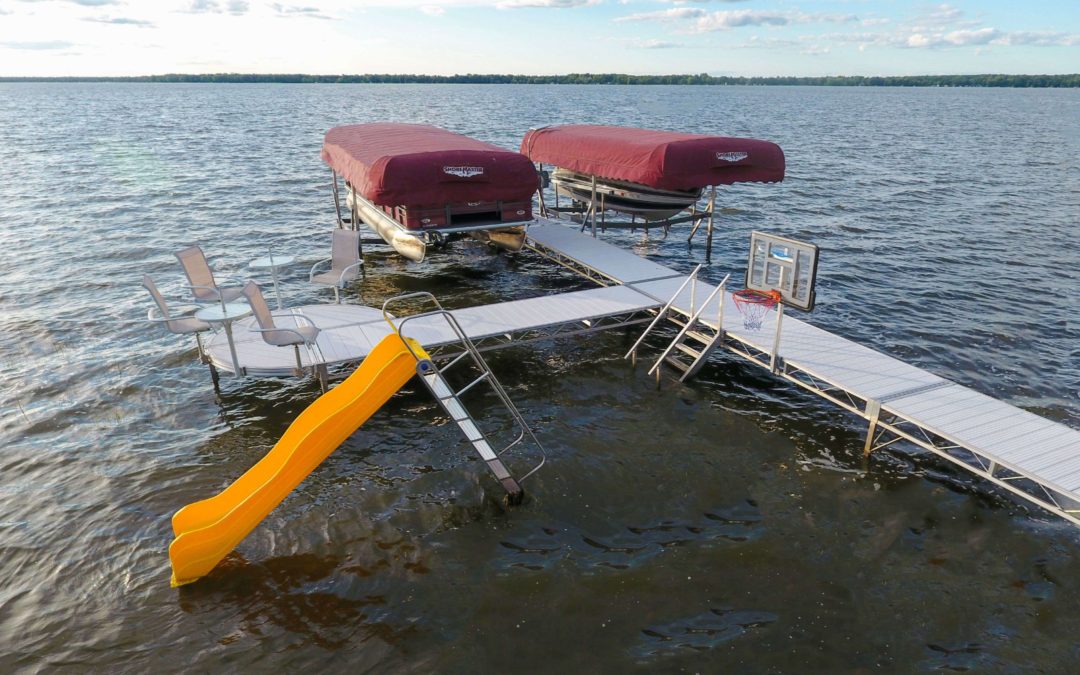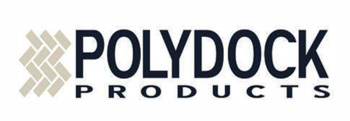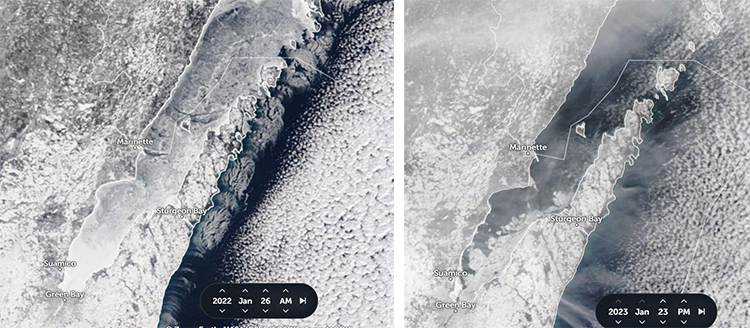
Mar 31, 2023
It may seem early in the season to be thinking about water levels but not for us! We need to know what to expect in the months to come to be ready for what may, or may not, happen. Summer water levels tell us how much pier our customers will need and where to install boat lifts. With extreme highs come shoreline damage, extra pipe for longer legs and big, damaging waves. With extreme lows, not enough pier to get adequate depth, higher demand for pier sections and extra work setting boat lifts. We’ve seen both of these issues within the past ten years. So what can you expect for this coming summer?
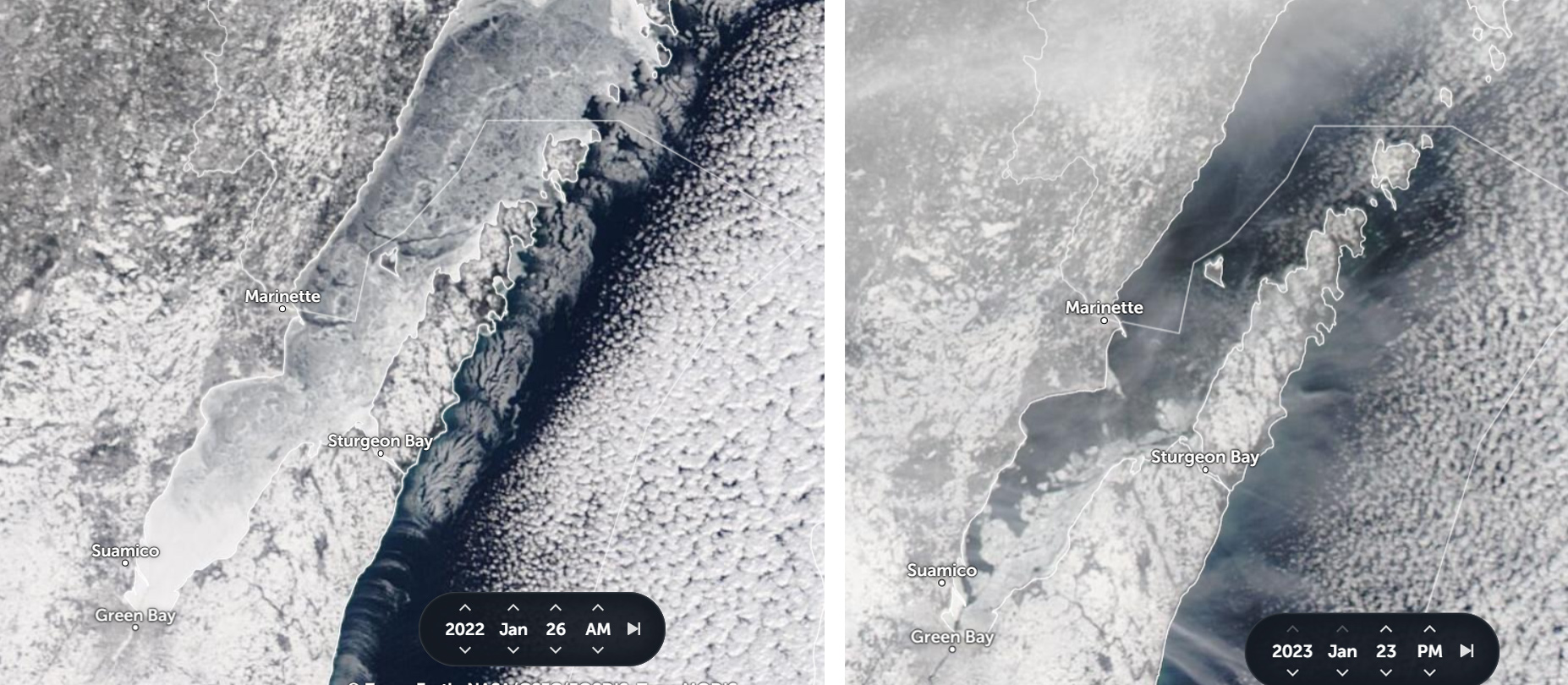
In order to know where our water levels will be this summer, you have to look at the condition of the lakes in the winter. Our current ice concentration on the Great Lakes remains below normal. If you look at the pictures in reference A, you will see the difference between the ice formation in late January 2022 and 2023.
So why is ice important you might ask? The amount of ice and snow formed over the winter directly affects the water levels in our lakes and streams come summertime. Without snow, we don’t have the snowpack melt needed to refill our aquifers in spring. On average, the melt from the snowpack is responsible for one third of the ground water we see in spring. Even though we may not have much snow in our specific area, we benefit greatly from the connection of the Great Lakes. Heavy snow fall in southern Canada melts and fills Lake Superior which in turn flows into Lake Huron which is hydraulically connected to Lake Michigan. The more snow the better too because the ratio of snow to water is only 12:1, meaning you need about 12” of snow to generate 1” of water. As snowmelt fills our lakes and streams, ice protects them from evaporation and outflow. Statistically we have lost 30% of ice coverage on the Great Lakes since 1970. Reduced ice cover leads to increased evaporation and lower water levels, as well as an increase in water temperature and sunlight penetration. This has caused lake ice to form later than usual, about a day to a day and a half per decade. The rising surface water temperature has also affected “ice off” or the thaw dates for ice on the Great Lakes. Earlier ice off dates, which is currently about 24 days sooner since studies began in the early 1900’s, means the lake absorbs more heat over spring and summer perpetuating the late ice formation. Another effect of the warmer surface water, reduced ice cover, and increased evaporation is a corresponding increase in precipitation over nearby land, especially “lake effect” snow. This precipitation is depositing the water evaporated from the western lakes over eastern states starving the aquafers of the wester lake’s bordering states. A smaller role ice coverage plays is in the outflows of rivers and streams from the western lakes into the eastern lakes as they deposit into the Atlantic. The ice coverage helps reduce the flow of water between the lakes and without it, more water is flowing and depositing into the Atlantic throughout the winter without being replenished by icepack or precipitation.
Now that we know the condition of the lakes in winter, what can we expect this coming summer? Stay tuned for next months blog to find out what we are predicting for water levels in summer and what you can do to stay ahead of it.
Citation
Sep 14, 2021
Are you a Pro with a Pontoon Boat?
Pontoon boats are a relaxing way to enjoy boating any season of the year.
It’s Fall, and there are still days when you will wish you could be out on a pontoon boat. It might be a little cooler, but after the hot summer, it will be refreshing.
Pontoon Boats are unique
Pontoon boats have their own style with many amenities available. These boats are different in many ways from a normal powerboat. Handling them is another animal to tackle. Check out this article to get the most use of your pontoon boat.
Docking and Undocking
Pontoon boats leave the dock like any other vessel on the water. Yet, their body shape creates more surface area for the wind to push around. It amounts to a “giant sail.”, the tubes and vertical fences found around the deck act as a sail.
Adding to that difficulty are the boat tubes, which provide your floatation. Large gusts of wind are your mortal enemy. They can knock you off course on the water. The ability to push your pontoon into other boats means you need to know how to handle a pontoon boat. Plus, you must have stellar insurance coverage. SEE
To counter the winds, you have to be aware of them at all times. The pontoon boat’s secret is its exceptional control when used with short bursts of power. Regardless of what type of boat you use, idle the engine and point the motor in the direction you want to go. Then shift into gear. Next, use short bursts of power as you steer the boat. Before you know it, you’ll be out of the dock.
You’ll use the same understanding of the wind and maneuvers when heading back into the marina. Docking any powerboat (pontoons included) requires a little more side-to-side motion. You can learn more about these actions via this link.
Beaching
Beaching or mooring your boat to swim is half the fun of boating, no matter what type of vessel you own. People love beaching their boats to explore islands or soak up the sun. Luckily, both are simple processes and the same for every type of powerboat.
Start by traveling slow when you hit shallow waters, so you don’t damage your motor. Beaching requires you to push the front end of your vessel onto land. Do this carefully to prevent damage to the tubes.
Don’t head onto the beach too far; allow enough room to spin the boat around out into the water using the motor.
For mooring, make sure you have the proper tools to secure your boat via the anchor. Pontoon boats are more buoyant, so use fenders to protect your boat from other vessels.
Turning and Handling
Pontoon boats soar across the water, which makes handling them a ton of fun. Before you lose yourself in the moment, remember that there are no lanes out on the water. Always check your surroundings before making a turn or spinning your boat around.
With that safety tip in mind, you’re ready to tackle the water. Pontoon boats are very stable. You don’t have to worry about flipping or rolling the boat over in normal conditions.
But rough waves and tight turns mean you can’t rule out the possibility. Still, it isn’t much of a concern for the modern pontoon boat.
You do have to worry about causing the propeller to leave the water when making a tight turn. You can either back off of the turn, deaccelerate or trim the engine downwards to remedy the issue. When making sharp turns, equipment and people on your deck are likely to be tossed to one side depending on the speed. Do they have life preservers?
Acceleration
Once you hit open waters, you’re ready to pick up speed. Don’t treat your pontoon boat like a race car, though. Instead, speed up steadily until you reach your desired speed. Keep in mind that the bow will level out, which means you’ll need to trim the engine if you want more speed.
Your engine might rise too far out of the water as you speed up. That’s normal and easy to fix by trimming the motor. Your boat may slow down, and you’ll hear a howling sound near the propeller. Or, the boat will lose a little stabilization when this happens.
Keep in mind that every boat comes with a manufacturer’s recommendation for top speeds or RPM. Most recommend 75% of fully open throttle. It helps to read up on this statistic before pushing your boat to its limits. Use less throttle for more fuel efficiency.
Keep in mind that more crowded waters demand slower speeds. There are rarely legal speed limits on open water, so be mindful of other boaters in the area. Keep an eye out for swimmers as you approach other boats or the shoreline.
Stability Tips in Rough Waters
A pontoon boat handles well, even in rough water, thanks to its dual or triple hull design. Yet, even with the added help, you need to drive a pontoon boat carefully in these conditions.
Experienced boaters recommended that you keep an even load on board. To do this, you must include both objects and passengers. When rough waters arise, make sure your passengers know to even out their weight on deck and sit down. Don’t forget to make them wear life preservers for their safety. The larger your boat, the easier this is to maintain.
Try to avoid heading straight into giant waves. Excessive splashing could damage the electronics in your boat if they take on water. If you must head nose-first into oncoming waves, trim the engine down to help keep the boat’s nose/bow upward. Otherwise, take the waves at a 30 to 40-degree angle.
Finally, sports handling packages are an enormous benefit here. These include better nosecones, power-assisted steering, and higher horsepower to combat choppy waters.
Become a Pro
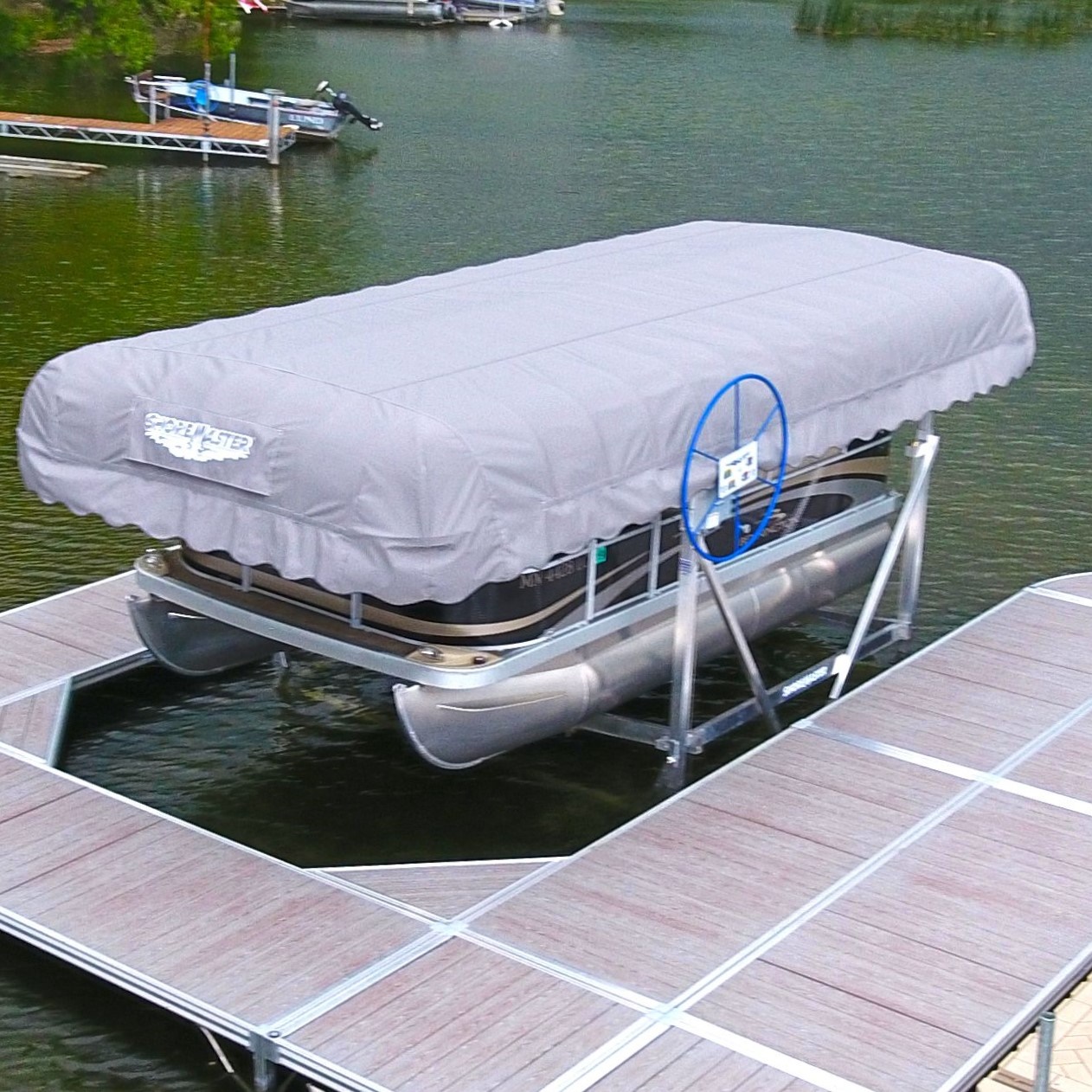
Pontoon Boat Lift
That means don’t head out onto the water when you know a storm is on the way. A pontoon boat is an investment you don’t want to risk for a few more minutes of fun. If inclement weather strikes, head back to the dock and put your boat back on your lift.
Where is Pier & Waterfront Solutions?
Located at 7325 St. Hwy 57, it’s 3 miles south of Sturgeon Bay and 1 mile past the intersection of Cty MM (heading north). Look on the right side, one mile north, at the next corner (Idlewild Road and Hwy 57).
For your protection PWS implemented these preventive measures:
1. Conducting as much business as possible by email, text, or phone.
2. Site visits will continue. When in-person contacts are necessary, we will follow “social distancing” guidelines.
3. Our display yard is always open for you to examine at your leisure. All displays have a numbered, red tag on them. If you want more information or pricing, please reference that number.
Thank you for allowing us to work with you.
YES – PWS is OPEN and waiting for you!
Please call, message, or email PWS with any questions.
Let’s all stay safe!




